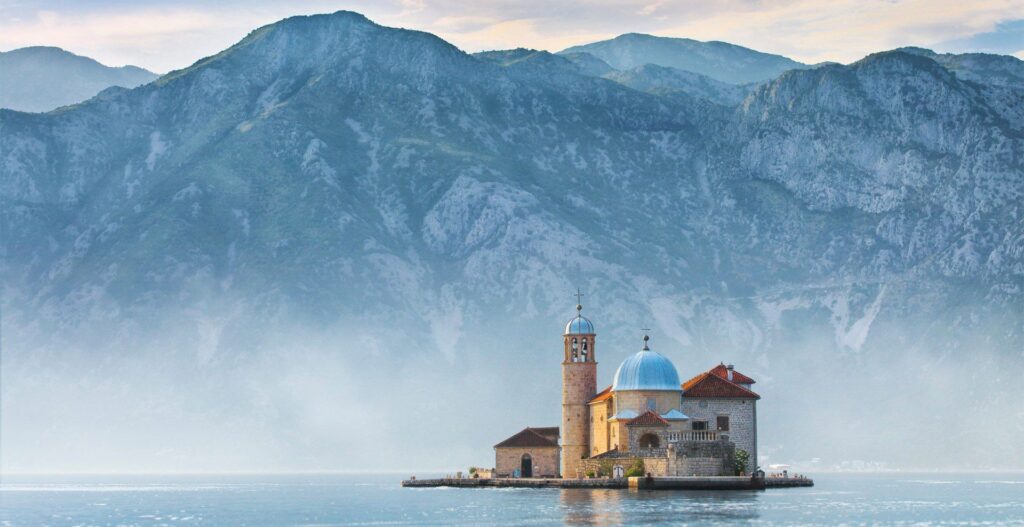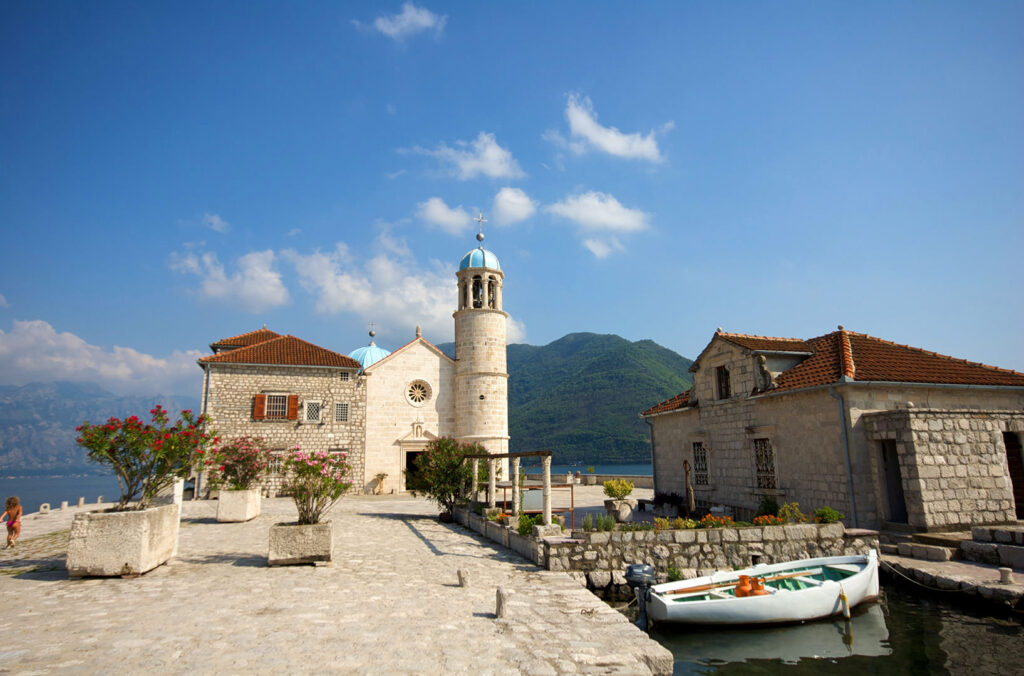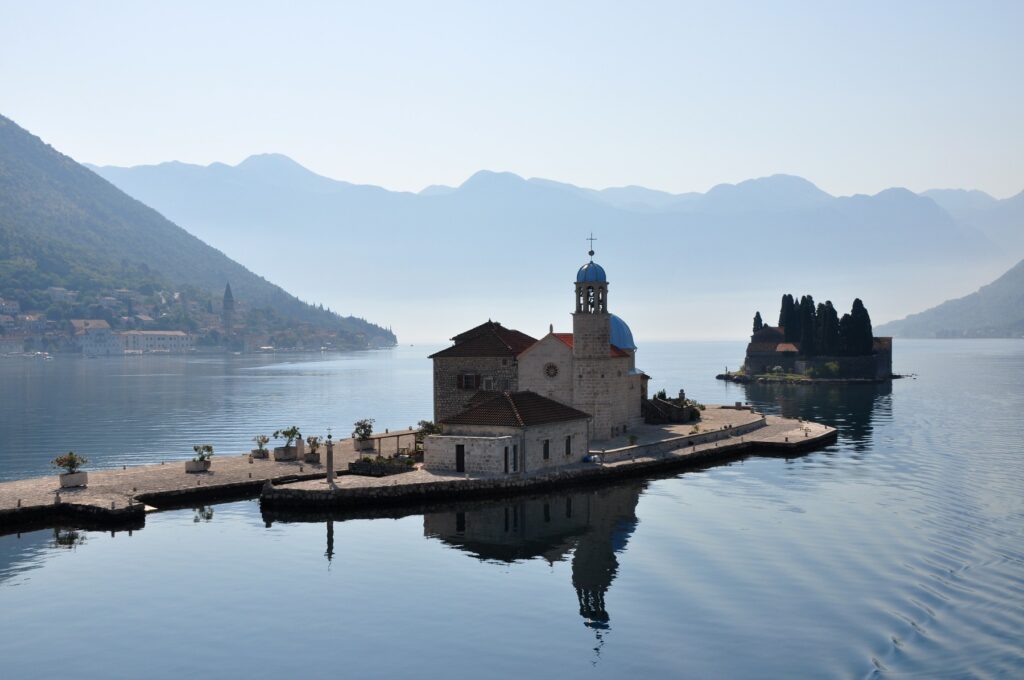geography of island Gospa od Shkrpjela
The Bay of Kotor, a winding bay on the Adriatic Sea in southwestern Montenegro, is home to many natural and man-made wonders. Among these gems is the Island Gospa od Shkrpjela, often simply referred to as “Our Lady of the Rocks”. Unlike its neighboring natural islands, this island’s origin is intrinsically linked to human activity.
The Island Gospa od Shkrpjela is an artificial island, which means it was created by deliberate human efforts. According to popular legends, the island’s formation started in the 15th century when local seamen discovered an icon of the Madonna and Child on a rock protruding from the sea. Taking it as a divine sign, they vowed to build a church on that spot. Over time, they dropped stones around the site, gradually leading to the island’s creation. This tradition continues today with an annual event where locals continue to throw rocks into the sea to further fortify the island.
Geography of island Gospa od Shkrpjela , the island enjoys a prime position in the heart of the bay, opposite the town of Perast. It’s relatively small, with its main attraction being the Roman Catholic Church of Our Lady of the Rocks, from which the island derives its name. The church’s bright blue domes against the backdrop of the azure Adriatic waters make it a picturesque sight, drawing tourists and photographers alike.
In essence, the geography of island Gospa od Shkrpjela is more than just an island. It stands as a testament to human faith, perseverance, and the age-old bond between man and the sea. This unique blend of natural beauty and human history makes it an indispensable part of Montenegro’s coastal heritage.

history of island Gospa od Shkrpjela
The history of island Gospa od Shkrpjela, nestled in the heart of the Bay of Kotor, carries with it tales of divine interventions, devout sailors, and historical ceremonies that have taken place over centuries. Delving into its rich history reveals the intricate tapestry of legends and events that have shaped its significance.
One of the most prominent legends tied to the island’s genesis revolves around the discovery of an icon of Madonna and Child on a rock in the sea by local fishermen in the 15th century. Interpreting this as a celestial sign, the sailors took an oath to construct a church on this very site. Every time they embarked on a successful voyage, they’d lay rocks and sink old boats around the protrusion, progressively forming the Island Gospa od Shkrpjela. This tradition, known as “Fašinada”, is still observed every July 22nd, where residents of Perast and surrounding areas gather to throw stones around the island, reinforcing its foundations and celebrating its origins.
The Church of Our Lady of the Rocks, which adorns the island, houses numerous art pieces, but one stands out both for its artistic and historical value. It’s a votive tapestry, crafted by a local woman over 25 years, using gold and silver threads but also incorporating her own hair. Legend says she made it while waiting for her beloved to return from a long journey, and as years went by, her hair turned from black to grey, which can be observed in the tapestry’s shifts of color.
Additionally, the island bore witness to various naval skirmishes given its strategic position in the bay. While the primary purpose of the island was religious, its location meant it inadvertently played roles in some regional maritime events.
In essence, the history of island Gospa od Shkrpjela is not just a picturesque spot in the Adriatic but a chronicle of faith, love, and history. Its legends and stories, passed down through generations, ensure that the island remains a living testament to the past, even as it welcomes visitors in the present.

Architecture of Island Gospa od Shkrpjela
Architecture of island Gospa od Shkrpjela, floating serenely within the Bay of Kotor, is not just an embodiment of natural beauty, but also an epicenter of Montenegrin architectural and cultural heritage. Every corner of the island whispers tales of historic reverence and artistic mastery.
The centerpiece of the island’s architectural marvels is undoubtedly the Church of Our Lady of the Rocks. Its elegant blue dome contrasts beautifully with the Adriatic’s azure waters, while the interiors narrate stories of faith and devotion through intricate frescoes and ornate altars. The church is also home to a wealth of Baroque artworks, with paintings by the renowned artist Tripo Kokolja adorning its walls. One of his masterpieces, “The Death of the Virgin,” captures attention with its profound detailing and poignant theme.
Adjacent to the church is a small museum, showcasing the rich tapestry of Island Gospa od Shkrpjela’s history. From delicate ecclesiastical garments to centuries-old navigation equipment, the exhibits transport visitors back in time, retracing the steps of sailors and devotees who once graced the island’s shores.
Moreover, the island’s cultural essence is not just limited to stationary artifacts. The aforementioned tradition of “Fašinada” reflects the island’s deep-rooted customs. This annual ceremony rejuvenates the bond between the island and its patrons, emphasizing the collaborative spirit that led to the island’s creation.
A lesser-known, yet equally captivating site on the island is a votive tapestry crafted painstakingly over 25 years. Interwoven with gold and silver threads, and made even more unique with strands of the creator’s hair, it’s a testament to love, patience, and unmatched craftsmanship.
To step onto the architecture of island Gospa od Shkrpjela is to traverse through time, witnessing the fusion of nature’s wonders with human artistry and devotion. From its sacred walls to its time-honored traditions, the island remains a beacon of Montenegro’s rich cultural and architectural legacy.

tourism on island Gospa od Shkrpjela
In the heart of Montenegro’s Adriatic coastline, Island Gospa od Shkrpjela emerges as a prime tourist attraction, offering a harmonious blend of historical significance, cultural treasures, and awe-inspiring beauty. Today’s visitors can experience a kaleidoscope of adventures and experiences that stay etched in memory long after the journey’s end.
Most journeys to the island begin with a tranquil boat ride from the ancient town of Perast. The sea’s gentle embrace and the silhouettes of surrounding mountains set the tone for the day’s exploration. As the boat approaches the island, its iconic church, with the distinctive blue dome, beckons travelers with an unspoken promise of stories waiting to be unraveled.
Upon tourism on island Gospa od Shkrpjela, guided tours are available for those eager to delve into the island’s rich history and legends. The church and museum hold centuries of art, relics, and tales. However, for visitors more inclined towards self-exploration, the island can be a serene escape, with plenty of nooks to find solace, perhaps with a book or a sketchpad.
Beyond the historical and cultural immersion, the island also offers numerous events, particularly during summer. Open-air concerts, art workshops, and traditional festivals breathe life into the stone pavements, creating a lively atmosphere.
For those seeking a truly immersive experience, the local “Fašinada” festival provides a unique opportunity. Tourists can join locals in this annual ritual, adding rocks to the island’s perimeter, strengthening the bond between man and nature.
Culminating a tourism on island Gospa od Shkrpjela often involves a leisurely evening at Perast. The local restaurants lining the bay offer a delectable range of seafood, accompanied by views of the island illuminated in the dusk.
As more travelers seek experiences that blend culture, history, and natural beauty, the allure of the Island Gospa od Shkrpjela continues to grow, promising every visitor a chapter of memories in their travel story.

